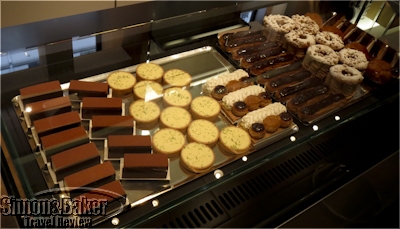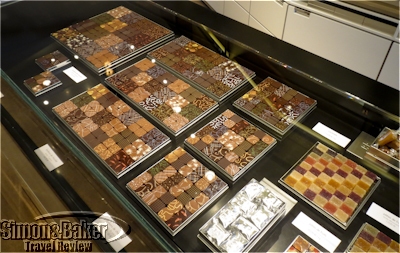Luxury Travel Review

Passionate chocolate, candy maker draw to Paris Marais shop
By Elena del Valle
Photos by Gary Cox
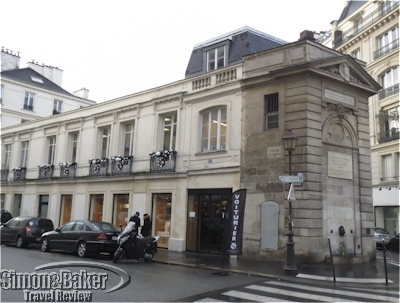
The shop and laboratory share space in this building
Jacques Genin loves chocolate. The self taught fondeur en chocolat, a chocolate maker who works with chocolate mixes (rather than raw cocoa beans), loves to make chocolates, candy and pastries, and eat them. We visited his spacious and modern shop in the Haute Marais neighborhood in Paris, France looking to answer two questions: What could make his shop special in a city riddled with chocolate and pastry shops? Would his products be so good as to draw us across town to the third arrondissement?
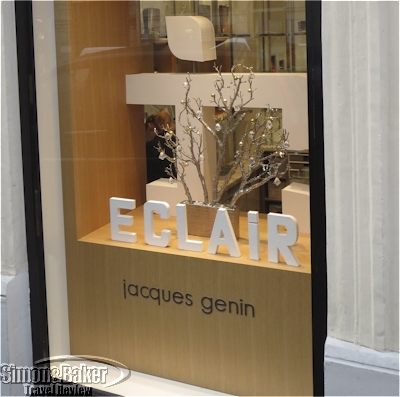
Each window featured one of the product lines
When we first approached the corner shop in a 17th-century double-fronted building we were surprised to see a voiturer or valet service at the entrance. Although we have seen valet service at many upscale shops and gourmet restaurants in Paris it was the first time we noticed one at a chocolate and candy shop. From the outside the window displays, even during the festive end of year season, were understated. As we entered the shop we were greeted by one of a half dozen staff members and directed to a table at the rear corner, behind a spiral staircase where a few minutes later we sampled hot beverages, chocolate and pates de fruit.
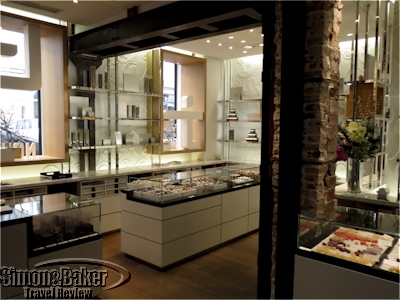
The public area on the ground floor of the shop was designed by Guillaume Leclercq
The busy shop, occupying the bottom part of a 400 square meter space, was uncluttered, organized and elegant. Designed by Guillaume Leclercq the public area featured exposed stone, steel beams and columns, red brick columns, panels of cream plasterwork, oak floors, polished stainless steel and a spiral staircase leading upstairs where the products were made fresh daily.
The pastries were made following traditional recipes (click to enlarge)
Friendly staff, some with gloved hands, assisted a steady flow of customers, many of them Japanese. We found out later that one third of the shop customers are from Japan. Near the entrance, there was a check-out counter where customers paid for their purchases after selecting their products at the section of their choice. A handful of steps led down to the main area with glass counters housing old style pastries (our chocolate eclair was delicious), caramels, chocolates, and nougats on the left. Pate de fruit, small sweet fruit paste cubes bursting with flavor, were in a stand alone counter in the middle. A selection of teas and coffee was available as well.
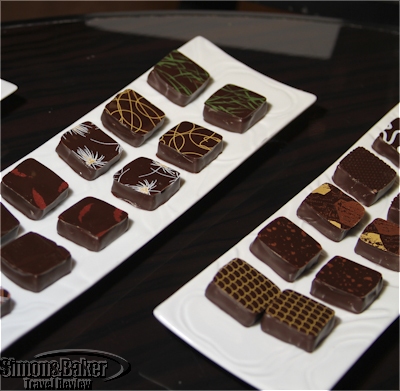
A selection of dark chocolates
So far so good, I thought. It wasn’t until, comfortably seated in leather armchairs next to the staircase, we sampled some of the fifty menu items that we understood what made Jacques Genin products noteworthy. Each bite size morsel had a flavor all its own, intense and unique. These flavors were worth a special effort.
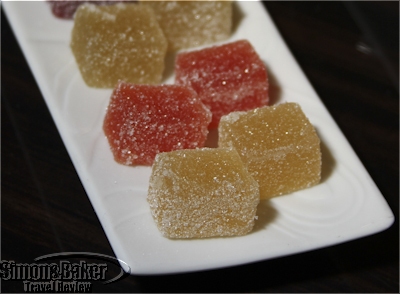
The pates de fruit were exceptional
The pates de fruit, available in nine flavors that day, were the best we have sampled. The flavor combinations, which vary with the season, were harmonious, sometimes unexpected. The ones we tried were were banana, black currant, blood orange, cherry, raspberry and rose, mango and passion fruit, rhubarb, pear and pineapple. To our surprise the pear flavor had a texture reminiscent of, well, pear.
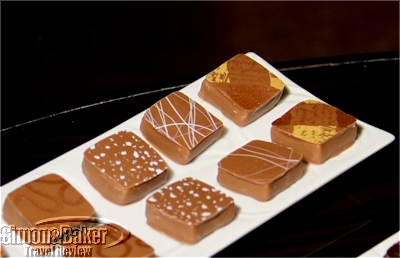
The milk chocolates
The chocolates, made fresh upstairs from 65 percent chocolate, were pretty with a strong distinctive taste. The fragrant ganache filling was well balanced and covered with an outer coat of chocolate, milk or dark. As soon as we bit into a chocolate piece the flavor popped. Moments later, the buttery chocolate joined the ganache in a perfect blend. While the dark chocolates, in the majority, were our favorites the milk chocolates were good as well.
Some of the dark chocolate varieties we sampled were: Mascarille made with Madagascar vanilla; Le beau tenebreux, just dark chocolate; Tonka teck, the tonka bean had an earthy taste; Sucre d’or made with chestnut honey; La belle epineuse with raspberry; Menthe amante (a favorite); Un grain with Szechuan pepper; Caravelle with mild spices; Rousse with cinnamon; C’est Noel with gingerbread; Bergame with bergamot; The toi with tea; Orangelique with orange; and Basilic instinct (a favorite).

The caramels, like the chocolates and pates de fruit, were flavor filled
Jacques Genin products are natural and fresh, never frozen, the owner explained. To obtain the most natural flavors he prefers to infuse plants and spices. As a result the chocolates have a short shelf life. For example, our box of chocolates from December 18 expired January 3. We ate the chocolates past their expiration date, and while they were perfectly eatable and buttery the strong distinctive flavors we had loved at the shop had slowly faded.
Some of the chocolates and candy tasted familiar like the mango and passion fruit caramel. It was no wonder since Jacques Genin used to sell his products to two hundred hotels and gourmet restaurants before he opened the shop in 2009.
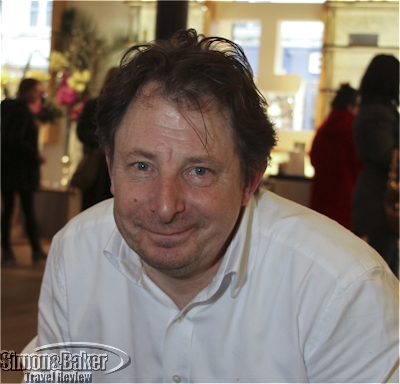
Jacques Genin was first drawn to chocolates for his daughter
As soon as he sat down to chat with us Jacques Genin, a reserved middle aged man who came alive when discussing his passion for chocolates and candy, began popping chocolates from our tasting tray into his mouth. When we asked which ones we should sample first and if there was a perfect order he smiled, reached for another chocolate and explained we should try them at random and simply enjoy them. When I wondered where the best chocolate came from he answered unequivocally, “Venezuela.”
The chocolate and pates de fruit were sold in metal containers to keep them fresh (click to enlarge)
Genin, a chef originally, began making chocolates for his young daughter and over time the business took over his life. It was evident to us that he loved the products he made and looked forward to arriving at work every day, a man who worked for passion and pleasure rather than to make a living or only to make money. The payoff was in the fresh and uniquely flavored chocolates and candy we sampled. The answer to both of the questions we had on arrival was yes. Chocolaterie Jacque Genin (133 rue de Turenne, 75003 Paris, France +33 1 45 77 29 01, contact@jacquesgenin.fr) became a favorite stopping point in our gourmet wanderings in Paris.
Art Deco hotel in center of Rome ideal base to explore city
Article and photos by Josette King
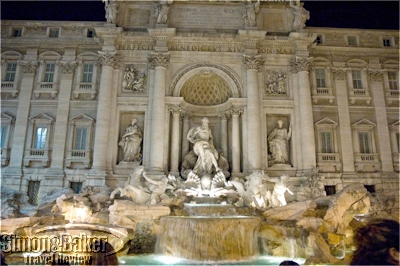
The Trevi Fountain at night
On my first visit to Rome many decades ago I threw the obligatory coin over my shoulder into the Trevi Fountain. It worked. Every few years I seem to come across a new opportunity to return, any excuse will do. Most recently, it was a fortuitous three-day stopover during an extended tour of the region. I deliberately had no agenda other than roaming around the city to soak up the atmosphere of a few favorites spots, and discover new ones along the way. Located in the center of Rome, a five-minute walk from Stazione Termini (Termini for short), the central train station, bus terminal and subway station, and within walking distance from most of the major tourist landmarks, the Hotel Mediterraneo first caught my attention as an ideal base for my explorations; and quickly intrigued me for its Art Deco origins, an architectural style I had not until now associated with the Eternal City.
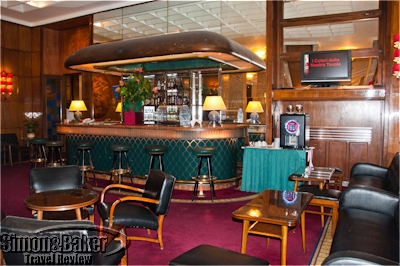
The bar at the Hotel Mediterraneo
Designed in 1936 by noted architect Mario Loreti for Maurizio Bettoja (then head of Bettoja Hotels), the property opened in 1942. To this day it remains the flagship of Bettoja Hotels, one of the oldest and largest family-owned hotel groups in Italy, now in its fifth generation. And with its original grandeur meticulously maintained by Maurizio’s successors, some consider the Mediterraneo among the finest examples of Art Deco architecture and rationalist design in Rome.
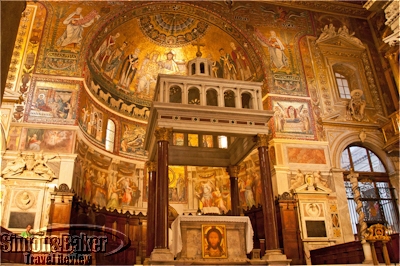
The Santa Maria Maggiore high altar
After a day of wandering through churches and palazzos filled with lavish millennia-old frescoes and extravagantly ornate carvings dripping with gold, the slick polished marble columns and exotic woods paneling of the airy and somewhat austere public spaces characteristic of the Art Deco style were a relaxing contrast. Common areas were filled with remarkable decorative elements of the era, and subtle reminders that, rationalism notwithstanding, eternal Rome endured.
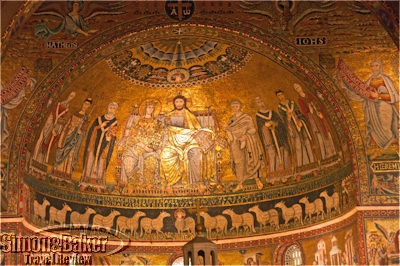
High altar Byzantine mosaic detail at Santa Maria Maggiore
In the lounge, a wall-size parchment map of an ancient perspective of the Mediterranean Sea was a reminder of the property’s name, as well as a nod to the Gallery of Maps at the Vatican. In the dining room, a stunning mosaic of a medieval hunt brought to mind the splendid tapestries of Renaissance palaces. Then there were the museum-worthy marble busts of Roman emperors interspersed throughout. I enjoyed walking through the majestic spaces and discovering new artistic details that had previously escaped my attention.
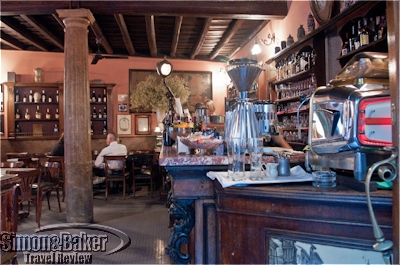
The Caffe della Pace
Although I discovered a new Rome favorite spot at the Mediterraneo, I didn’t neglect my old friends. I paid a neighborly visit to Santa Maria Maggiore. Built in the fifth century, this ancient Basilica still glows from the gold of byzantine mosaics that cover its triumphal arch and high altar. I headed to the Trevi Fountain for a quick nod of thanks. I couldn’t resist dropping by the Pantheon where for a few euros, tourists from around the world have their pictures taken with centurions in crimson capes and plastic armors. I stepped inside as well, to stand under the perfect rotunda and look up at the sky through its central oculus.
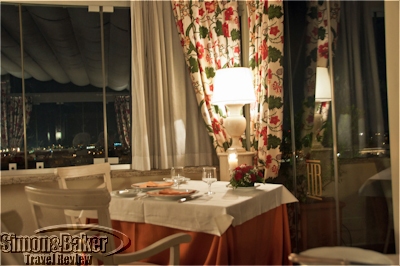
The Hotel Mediterraneo Roof Garden dining room at dinnertime
I went to Piazza Navona to take a fresh look at Bernini’s Fountain of the Four Rivers, which had been under wraps for repairs on two previous visits. Then I wandered into the old streets behind the Piazza, to the Caffe della Pace, a neighborhood favorite for over a century, in the street of that lent it its name, for a Spritz (popular local cocktail made of dry white wine, sparking water and bitter Aperol).
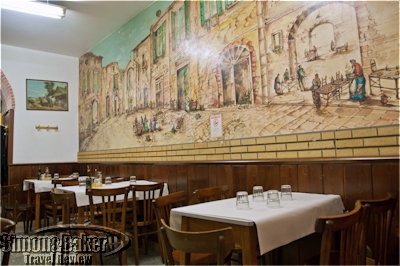
A favorite no-name fish eatery near Campo de Fiori
Thus reinvigorated I continued down the street to Santa Maria della Pace (Saint Mary of Peace) for a glimpse at the exquisite Raphael frescoes in the Chigi Chapel. I visited Campo de Fiori for the daily open market and the surrounding back streets where traditional artisans and avant-garde designers share the narrow storefronts and cobbled courtyards. And I stopped at a hole-in-the-wall fish place with paper tablecloths where market vendors drop in for a quick bite over high-decibel conversation, and neighborhood residents dash in for take-home fried fish. I don’t believe it has a name, but the fried calamari was out of this world.
Hotspot mobile device worthy addition to Paris trip
Article and photos by Gary Cox
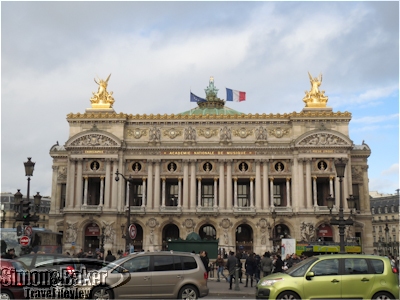
Walking is the best way to see Paris
We recently spent some time in Paris during which we had a chance to try out the Flat Rate aXcess Plan from XCom Global, a MiFi service with a daily flat rate fee which provided us Internet mobile connectivity for up to five devices in France. The aXcess MiFi Mobile Hotspot box which provided the service fit in my pocket and gave us mobile data access wherever we traveled in the city. While service above ground was superior it also worked in the underground subway. Most of our handheld devices support wireless access, but for this trip the star was our Samsung Galaxy tablet.
When connected to the MiFi, the tablet’s map application found our position, including the street and direction. In the same way as a GPS (Global Positioning System) unit in a car, the tablet program offered verbal and text walking directions on the map as we explored the city on foot. This feature alone made having the MiFi along worthwhile. Also, having Internet access came in handy to compare prices online when shopping and to discover the right bus or subway to take on the RATP (Régie Autonome des Transports Parisiens or Autonomous Operator of Parisian Transports) website. The MiFi service heightened our touring experience significantly.
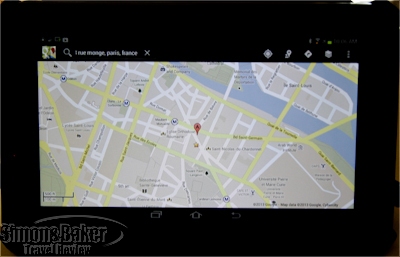
Paris streets are challenging even with a map
Although we own a MiFi unit that we use at home in the United States to use the service outside the country we have to register for a plan with a limited amount of bandwidth. Because none of our vendor plans allows unlimited data even a small overage can cost hundreds of dollars. At the same time, connectivity is uncertain. For example, the first time we contacted our vendor, even after multiple calls, the unit never connected on a trip to Asia. We were unable to find out if the issue was frequency compatibility, roaming arrangement or something else. On the second try, we had a good experience in the Caribbean (see ATT Elevate 4G portable hot spot on the road).
The XCom service allowed us to bypass the geographic uncertainty since the service we had was specifically for France, and the bandwidth overage concerns. As long as we made reasonable use of the connection overage was not a concern. The company’s Fair Use Policy stated, “Our standardized FUP policy: if you reached 400 MB within a 3 days period, the service might get suspended or get slower.”
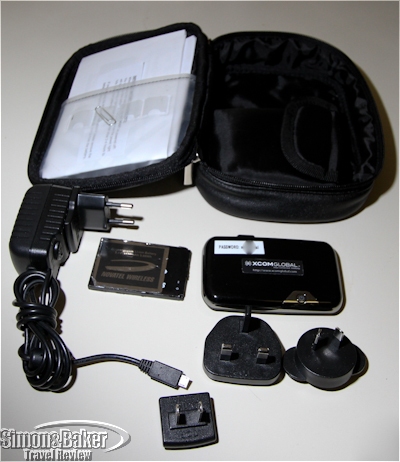
The XCom Global MiFi aXcess Mobile Hotspot kit
XCom Global service filled a niche, allowing us to plan the exact cost for unlimited use (within reason) of a MiFi with the correct mix of frequencies and data plans to roam in our destination country. Fair use policies in some countries limit bandwidth daily, but the data plan had no overage fees. The Flat Rate aXcess Plan MiFi device used the 3G network, not the fastest option, but widely available.
The kit included two batteries, a charger with multiple plugs, instruction manual and a case. XCom Global shipped the package to arrive the day before our departure to France and included a return mailer for its return the day after our arrival home. The insurance seemed wise considering the high cost to replace the unit if lost or stolen ($800). I would consider using the Flat Rate aXcess Plan from XCom Global, Inc. (5910 Pacific Center Blvd, Suite 320 San Diego, CA 92121, +1 858.222.8242, +1 858.222.8243, info@xcomglobal.com, http://www.xcomglobal.com/) in the future.
Spa, haute cuisine restaurant in secluded Alsatian forest
Article and photos by Josette King
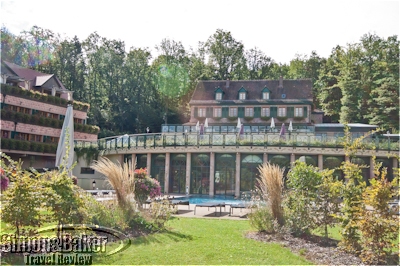
The property was located on three terraced levels
The Romantik Hotel and Spa les Violettes was the last stop on the itinerary of my recent visit to Alsace, France. I had spent a few days taking in the rich medieval art and architecture for which the area is renowned and enjoying its glorious wines and traditional cuisine (Paté de foie gras originated here in the 18th century). Les Violettes was just the right place to unwind before returning to Paris. Nestled in the densely forested foothills of the Vosges Mountains at the edge the Route des Vins (Alsace’s famed Wine Road), yet a mere 25 kilometers (16 miles) from Colmar, the property boasted superb spa facilities. In addition to three saunas with various heat and moisture levels, a steam room and whirlpool bath, there was an unusual halotherapy salt-cave and a grand counter-current indoor-outdoor pool that was a swimmer’s dream. The spa also had six private treatment rooms where it offered a range of massages, facials and body treatments.
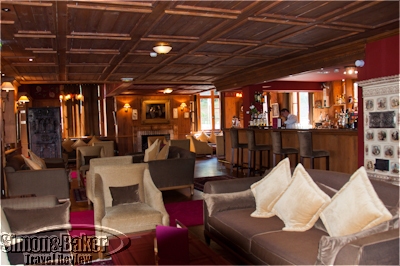
The Les Violettes bar sat in the corner of the open plan lounge
Then there was Le Jardin des Violettes, the property’s outstanding restaurant. In a region that has long held bragging rights for being home to an exceptional density of noted chefs and multi-award restaurants, Le Jardin des Violettes exceeded my expectations. The elegant dining room was decorated in warm shades of cinnabar and taupe that gave the formal space a cozy atmosphere. Subtle indirect lighting filled the room with a faint rosy glow that enhanced the formal table setting and provided just the right touch of romance to showcase the exciting creations of Chef Jérôme Jaeglé.
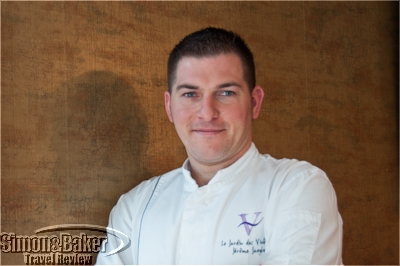
Chef Jerôme Jaeglé
Before taking over at Le Jardin des Violettes in early 2012, this talented young chef still in his early thirties, accumulated impressive credentials, including working as chef at Jean Yves Schilinger (a Colmar institution) and at Christian Têtedoie in Lyon. He found time to excel in some of the most respected French and international culinary competitions. A two-time winner of the National Taitinger Competition (in 2006 and 2008), recipient of a bronze medal in the Paul Bocuse European competition in 2010, he went on to take fourth place in the 2011 Bocuse Worldwide event. But through it all, this Colmar native maintained his passion for the bounty of the Alsatian countryside. During my visit, he explained that he lets the seasonable availability of locally sourced products guide his creativity. And he leads his team into foraging expeditions in the forests surrounding Les Violettes to gather the wild mushrooms and commercially unavailable greens that give his cuisine its unique cachet.
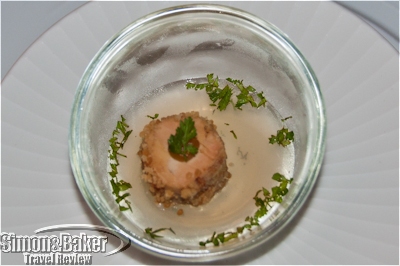
Foie gras on jellied green tea
I dined twice at Le Jardin des Violettes, and from amuse-bouche to dessert, each dish was an imaginative creation that delighted the eye and the palate. A light base of jellied green tea offset a rich nugget of paté de foie gras; chestnuts enhanced a wild mushroom duxelle, a simple mousseline of potatoes rose to the culinary stratosphere when whipped with walnut oil and garnished with oxalis (tiny wood sorrel leaves with a tangy, peppery taste). I can still taste a divine grilled filet of red snapper served with its skin deeply scored into julienne strips and caramelized crackling-style, while the tender white fish beneath was cooked to delicate perfection. And how could I forget his sublime cassolette (small casserole) filled with a fricassee of freshly gathered wild mushroom that concealed a farm-fresh egg softly poached in mushroom juices? Small wonder that Le Jardin des Violettes was awarded Two Toques from Gault et Millau in 2012.
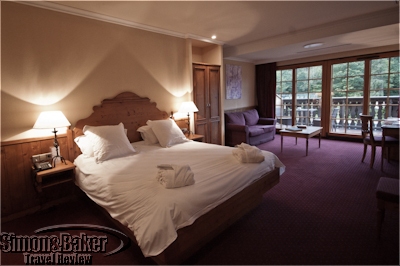
My room opened onto a large deck
The service was equally superb, unfailingly attentive yet unobtrusive. The extensive wine list included a wide selection of Alsatian wines as well as other wine-growing regions of France. From it, Alexandre Figenwald, the knowledgeable young sommelier, assisted us in selecting just the right bottles to enhance our meals (including a memorable Riesling Grand Cru Schlossberg 2010, Domaine Weinbach, Kayserberg). The one drawback of having experienced Chef Jaeglé’s cuisine is that it has become a personal benchmark against which most restaurants I have visited since Le Jardin des Violettes find it hard to measure up.
New Paris restaurant offered exceptional seafood in unassuming setting
By Elena del Valle
Photos by Gary Cox
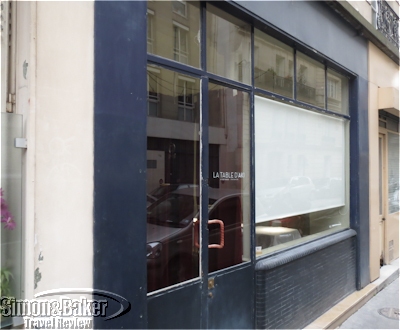
The simple storefront of La Table d’Aki
On our most recent stay in Paris, we dined twice at Table d’Aki, a new neighborhood seafood restaurant led by Chef Akihiro Horikoshi we much appreciated. While some aspects of the experience were less than stellar the meals themselves were outstanding and the reason we plan to return to and recommend the 16-seat unadorned restaurant with a staff of two, the Japanese chef and owner who prepared French food, and a server.

St. Pierre fish over vegetables
The first time we went to the Seventh Arrondissement restaurant with such a discreet sign we almost missed it we were forty minutes late for our 1 p.m. reservation. Although the previous day we had reconfirmed our reservation, as is customary in fine dining restaurants in that city, we had no mobile phone on us and traffic was thicker than we anticipated during our cross city trek resulting in our tardy arrival. An unhappy server allowed us to sit down but informed us, after consulting with the chef of the less than half full restaurant, that we were welcome to stay provided we dispensed with the starter option and only had a main (and dessert we discovered later).
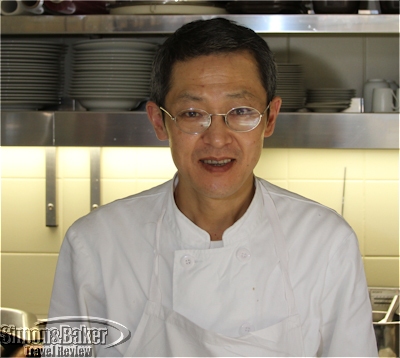
Chef Akihiro Horikoshi
In addition to being eager to sample the cuisine we were hungry so we agreed to the condition. Within minutes we were seated at a window side table with white tablecloths and ordinary dinnerware sipping a glass of disappointingly lukewarm Krug champagne, hoping for a slice of bread and glancing out the window onto the quiet street and indoors at our surroundings. The restaurant had a minimalist design with bare eggshell walls. Individual lamp bulbs hung above each table, suspended from red cordoned leashes that joined together at the ceiling. Tables for two that could be set together for larger groups occupied two rows set against the wall from the curtained entrance to the open kitchen. One row, ours, was longer than the other. A door to the rear left led to a hallway, office and single restroom.
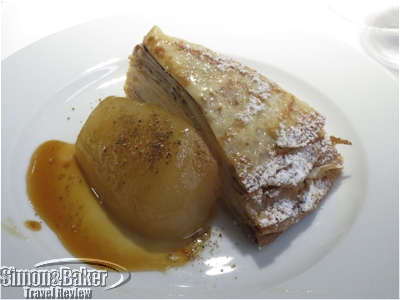
The thousand layer crepe dessert
Moments later a perfectly prepared and seasoned St. Pierre fish, one of two main course options, with a light brown sauce arrived, erasing all unhappy thoughts. Just after bringing the fish to our table the server brought a basket of bread. A thousand crepe with pastry custard was the single dessert on offer. The light yet flavorful dessert completed the meal and left us wanting to return.
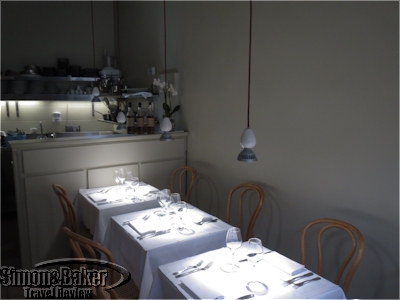
The dining area was adjacent to an open kitchen
Several days later, we were the first guests to arrive for our second meal. The server, the same slender blonde woman from the previous visit, commented on our on time arrival as she took our coats and offered us the table of our choice. Once again the restaurant was less than full for the lunch service. We were surprised to see her turn away two parties that arrived without reservations, explaining with emphasis that reservations were mandatory.
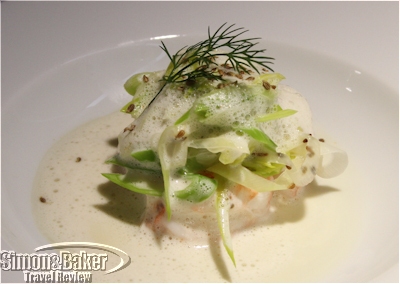
The langoustine appetizer
We overheard one of the parties explain that they had attempted to make reservations but were unsuccessful in reaching anyone over the phone. I empathized as I had trouble myself. The first time I attempted to reconfirm our reservation it took several tries in the space of 90 minutes to get through the busy phone line. The second time I called several times with no response, not even an answering machine.
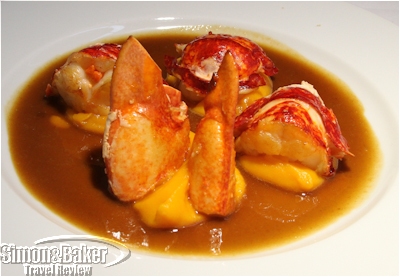
Brittany lobster with brown sauce and mashed pumpkin
On reflection we realized that if they had welcomed the unexpected guests those guests who had taken the time to reserve a table in advance would probably have been left with fewer choices from the limited menu. This policy heightened our opinion of the chef, said to have been a longtime cook at one of the city’s top gourmet restaurants.
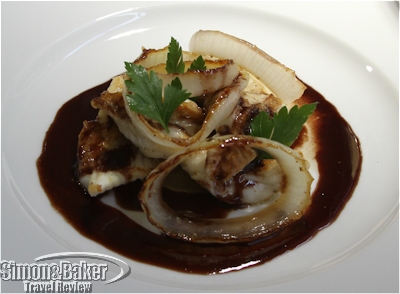
Fillet of sole with onions
From our seats we could see the chef cooking in the clean and well organized looking kitchen adjacent to the dining area. An advantage to the proximity was that our dishes arrived hot straight from the open kitchen (the scent of cooking was at times pervasive although it didn’t detract from our meal). On one occasion when one of our dishes was ready and the server was busy at another table the chef himself brought the dish to our table.
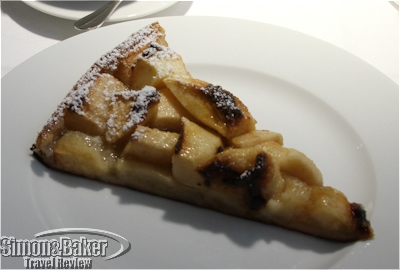
The apple tart
We sampled both appetizers on offer, St. Jacques and langoustine dishes, with favorable results. From the three main courses we sampled two, a small sole dish and a Brittany lobster with two sauces set atop mashed pumpkin (codfish was the third option). Both were delectable although the lobster was our favorite.
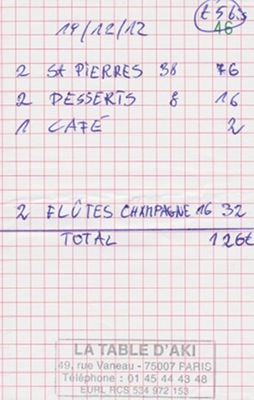
The handwritten bill for our first lunch
We opted for a half bottle of chilled 2010 Pouilly Foume Les Clarieres, a good match for the seafood. Dessert that day was homemade apple tart. Our server explained, when I asked if it had been made there, that the chef made it from scratch including the pastry. It was the perfect ending to a wonderful meal. We look forward to revisiting Table d’Aki (49, rue Vaneau, 75007, Paris, France, +33 1 45 44 43 48) the next time we are in the City of Lights, making sure to reserve a table and arrive on time.
Colmar visit memorable for gastronomic, cultural offerings
Article and photos by Josette King
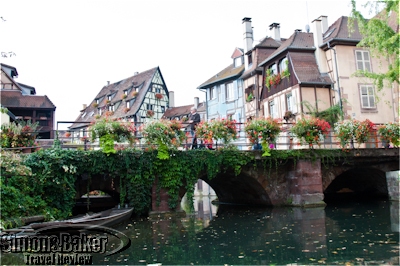
La Petite Venise was once home to tanners and fishmongers
Alsace, this strip of fertile plain stretched along the western bank of the Rhine River in the northeastern corner of France, is a region long on history and charm. The object of a millennium-long tug-of-war between France and Germany, it has successfully integrated elements of both cultures into a unique personality: decidedly French but with a noticeable German flavor in its architecture, arts, cuisine and traditions. And in spite of its troubled past, it has managed to preserve most of its cultural patrimony. Nowhere is that more evident than in Colmar, the medieval architecture gem in the heart of La Route des Vins, the much-visited hundred-mile country road that meanders north to south through the Alsatian vineyards.
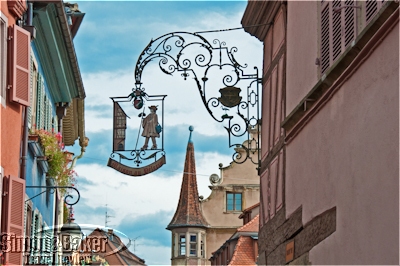
Antique wrought iron signs are still a common sight in Colmar
Mainly spared the destruction of the French revolution and two world wars, Colmar has an exceptionally large and well-preserved historic center for a city its size (population 65,000). I appreciated its laidback small town joviality and its easily walkable cobblestone streets lined with architectural treasures that span eight centuries of combined French and German evolution. At the edge of the historic town, the especially picturesque La Petite Venise (Little Venice) neighborhood is clustered around a network of canals from the River Lauch, where tanners and fishmongers quarters were once located. Farmers also used these waterways to ferry their products to the town market in small pole-propelled wooden barges. Similar barges are in operation today, with silent electric motors, to allow visitors a close look at the ancient (and still inhabited) riverside homes.
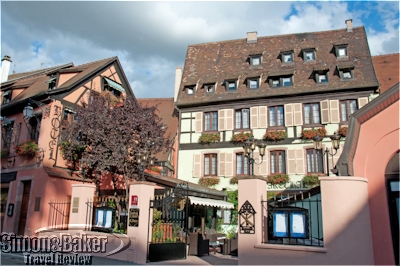
Romantik Hotel Le Maréchal opened onto a private courtyard
One of the finest historic properties of La Petite Venise is the picture perfect Romatink Hotel Le Maréchal. The luxury hotel was created from four adjoining 16th century half-timbered houses with their steep tiled roofs and neat rows of windows underlined with flower boxes overflowing with red geraniums. The rear of the hotel abuts the edge of the river, while the façade opens onto a small private courtyard. Inside, common walls have been opened and passageways link the various common areas with a maze of cozy nooks filled with antiques. An elevator is discretely tucked in a remote corner. My room, located under the eaves at the very top of the property, had slanted beamed ceilings and dormer windows that overlooked the roofs of the old town.
With its rustic Alsatian décor (discretely enhanced by 21st century amenities) it was a charming nest that beautifully captured the romance of the historic city. Equally appealing L’Echevin Restaurant occupied the entire rear of the first floor. There the space had been cleverly distributed to form a long, intimate dining room lined with picture windows that overlooked the river. It provided a worthy setting for the excellent cuisine of Chef Thierry Chefdeville, who has officiated in the kitchen for over a decade, earning such coveted recognitions as two toques from Gault et Millau and three forks from Michelin along the way, and firmly establishing L’Echevin’s standing as a noted destination for Alsatian gastronomy.
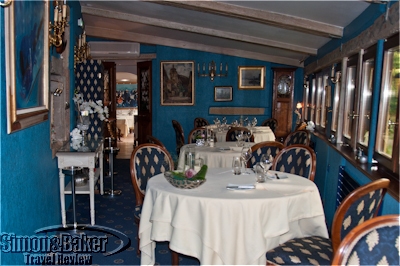
The restaurant, L’Echevin, overlooked the river Lauch
The pleasure of my stay at Le Maréchal, along with a couple of superb dinners at L’Echevin and the opportunity to wander at leisure around neighborhoods of meticulously maintained medieval houses would be reason enough for a weekend break in Colmar, especially now that several daily TGVs (Train à Grande Vitesse) have made it an easy three-hour and twenty minutes ride from Paris. But on this recent visit, there was also the lure of the town’s foremost artistic treasure: the Unterlinden Museum. Housed in a 13th century Dominican Sisters’ convent that is in itself a fine example of Gothic conventional architecture, the Unterlinden Museum holds a rich collection of Upper-Rhenish medieval and early renaissance sculptures and paintings.
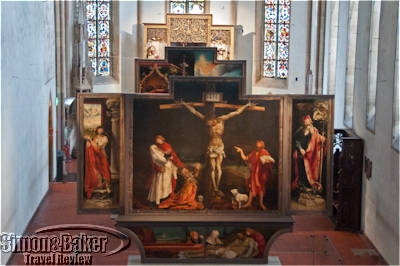
Matthias Grünewald’s masterpiece, the Isenheim Altarpiece is on display at the Unterlinden Museum
In addition to works by Lucas Cranach the Elder and Albrecht Dürer, it features several notable altarpieces by 15th century native son Martin Schongauer, and above all what is widely acknowledged as early 16th century master Matthias Grünewald’s greatest achievement: the Isenheim Altarpiece. Originally painted in 1512-1516 for the Monastery of Saint Anthony in Isenheim near Colmar, this unique oil on wood triptych has a center panel 2,70 meter (8 foot 10 inches) high by 3,10 meter (10 feet) wide depicting an especially poignant crucifixion scene. It was customary at the time for such triptychs to open to reveal additional scenes inside.
In the case of the Isenheim Altarpiece, there are actually two sets of wings, therefore two interiors. The first is a set of four panels depicting various scenes featuring the Virgin and Christ. The second interior is a carved shrine containing a polychrome sculpture of Saint Anthony flanked by Saints Augustine and Jerome, by sculptor Nicholas von Hagenau, with two more paintings (the Meeting of Saints Anthony and Paul, and the Torment of Saint Anthony) on the wings to the left and right respectively. In anticipation of its 500th anniversary, the masterpiece had been removed from view for restoration in recent years, and returned on display earlier this year.

